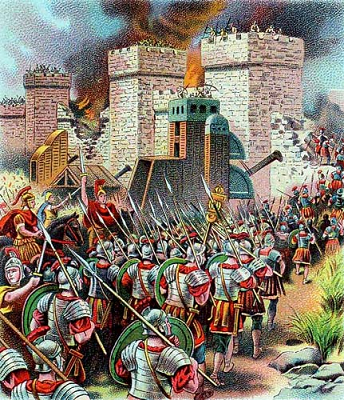September 14, 2006.
Jesus astounded His disciples with the news that the temple would be so badly destroyed that not one stone would remain upon another (Matt. 24:2). This prediction was powerfully fulfilled forty years later, in A.D. 70. Jesus also told His disciples how to escape that devastation: “When you therefore shall see the abomination of desolation spoken of by Daniel… flee into the mountains” (Matt. 24:15-16). Yes, but what is the “abomination of desolation” they were to look for?
Daniel wrote of abomination three times, and each time he connected it to desolate or desolation. In 11:31, Daniel connected the words to one of the four divisions of the Grecian Empire (see 11:2-5). It is widely understood that this abomination of desolation was fulfilled by Antiochus Epiphanes, who lived in the second century before Jesus. Dan. 12:11 seems to relate to the same time. Inasmuch as Jesus was predicting the future, he would not have been referring back to Antiochus. The third time the words appear in Daniel is in 9:26-27: “Shall Messiah be cut off… and the people… shall destroy the city and the sanctuary… for the overspreading of abominations he shall make it desolate.” The Messiah would be killed and afterward the city and temple would be destroyed with abominations that make desolate. This must be the Daniel text that Jesus had reference to.
Futurism says the abomination of desolation is yet future, involving a rebuilt temple in Jerusalem. However, this violates the context of Matt. 24. When Jesus said “there shall not be left here one stone upon another,” He and his disciples were looking at the temple then standing in Jerusalem. Jesus’ prediction was literally fulfilled in A.D. 70, and there has been no temple there since. Jesus was giving His disciples a sign that they could see so that they could escape that awful destruction. Any explanation of abomination of desolation that is later than A.D. 70 does not fit.
Neither can the fulfillment apply to anything the Romans did soon after they destroyed Jerusalem. The “abomination of desolation” that Jesus spoke of must refer to someone or something shortly preceding the destruction of the temple and all Jerusalem in A.D. 70. This leaves us with two possibilities, briefly explained below. If any reader of this Insight is aware of any third possibility, please send me an e-mail in reply.
1. The most obvious possibility is the one found by comparing Matt. 24:15 with Luke 21:20. The contexts in the two Gospels are parallel one to the other. Both say, “When you see… flee.” Matthew says, “see the abomination of desolation… in the holy place.” Luke says, “see Jerusalem compassed with armies.” Many believe that Luke’s expression is the divine interpretation of Matthew’s expression. The Romans were an abomination, being Gentiles threatening holy ground. The battle standards the Romans carried were virtual idols, thus an abomination to the Jews. And it was the Romans who made Jerusalem desolate.
2. The other possibility is that the abomination of desolation was something in the temple itself. This view finds the fulfillment in the Zealots, together with the Idumeans, who installed an illegitimate high priest, Phanni, murdered the real High Priest, Ananus, and filled the temple with drunkenness and human blood while they made it their fortress. This abomination by the Jews themselves is what brought on the desolation of Jerusalem.
Two interesting possibilities. Next time, Lord willing, I will discuss the pros and cons of these two views. Which one was the sign for the disciples to flee to the mountains?
